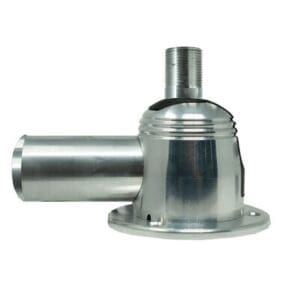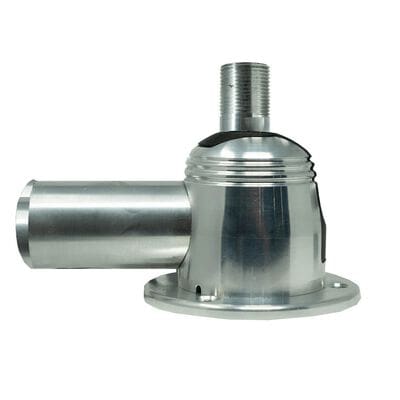
by Bill Morris
While we are perusing the various types and brands of radios for our boat’s nav station, we should give ample attention not only to what type of VHF antenna we intend to install, but the mounting system for that antenna as well. Holding the antenna securely to the deck, mast or aft pulpit plays a critical role in getting our signal out efficiently and safely, especially in an emergency.
To be sure, if you are crossing oceans, you will undoubtedly carry, at the very least, an antenna for your marine SSB or ham radio station, but we’ll leave those for another discussion. These radios, along with a satellite phone and possibly a satellite antenna, are also critically important pieces of equipment.
The most common location of a VHF antenna, particularly on smaller vessels, is at the masthead. A short whip antenna attached to a length of RG-58 coaxial cable is the standard fixture on vessels less than 40 feet.
Often on larger vessels, the antenna is mounted to a fixed or adjustable mount made of either stainless steel or nylon. The antenna coupling is a short, threaded post onto which the antenna is secured.
While underway, depending on the direction the antenna mount is facing, you can adjust the angle for an optimum transmission pattern, allowing for maximum range. The flatter the signal transmission plane, the more effective range you have for getting out your signal.
At the humbler end of the antenna mount spectrum is a deck-mounted, fixed, nylon or stainless stub, which you can pick up at virtually any chandlery for less than 20 bucks. This ensures a safe, stable mount, but just as with a masthead mount, it lacks the advantage of strategic adjustability for maximum coverage area.
A big step up would be Shakespeare’s QCM-S Quick-Connect Mount, which retails for about $100. This dual-axis ratchet mount, which is to be bolted to a deck structure, can be adjusted through 180 degrees vertically or 360 degrees horizontally to fit the transmission needs of any angle of sail.
The QCM-S comes with a pre-installed 20-foot length of RG-58 coax cable and a Centerpin PL-259 connector, saving you the hassle of having to strip the cable and solder it to the connectors at the time of installation.
The nylon version of the QCM-S, the QCM-N, is essentially the same system, along with RG-58 cable and PL-259 connector, but sells for about half the price. The advantages here are avoiding galvanic action with a different grade of stainless tubing and the tarnish that inevitably will attack the QCM-S.
Of course, you can opt instead for a free-standing, adjustable, screw-mount device without the built-in RG-58 cable. The advantage here is being able to change the coax without having to purchase a whole new antenna system.
If you want the best VHF antenna system money can buy, consider the Taco Marine Grand Slam 850 Electric VHF Antenna Mount, which you adjust with a button mounted in the nav station. The motorized Grand Slam is intended for mounting on a horizontal surface out of the way of the boom.
With the Grand Slam 850, you will need to hide the wires inside the paneling of a hard dodger or through a stainless tube on their way to the electrical panel. At roughly $750, this is a far cry from the humble mast-mount system to which most of us are accustomed.
The Grand Slam 800, available for about $100 less, is a purely manual device, permitting you to adjust the antenna through 360 horizontally and 180 vertically via a hand-operated crank. Like the Grand Slam 850, in order to adjust the Grand Slam 800, it must be mounted to the nav station roof. But then, wouldn’t that be the same as manually adjusting a Shakespeare QCM-S or ACM-N? We’ll let you be the judge.
Regardless of the brand or type of VHF antenna you select, most of the products you will find on the market are of good quality. Pick the antenna mount best fitting your sailing lifestyle and pocket book.
Circumnavigator-author Bill Morris believes the best strategy for succeeding as an offshore voyager is to keep systems simple and, if possible, manual. Key to survival are a windvane self-steering system, a basic array of electronics and an aggressive alternative energy battery charging matrix. Bill is an Ocean Navigator contributing editor and the author of The Windvane Self-Steering Handbook (International Marine, 2004) and The Captain’s Guide to Alternative Energy Afloat (Seaworthy Publications, 2019).

